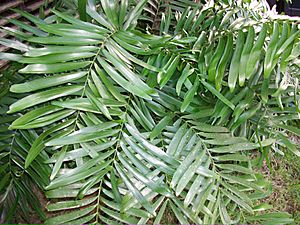Zamia erosa facts for kids
Quick facts for kids Zamia erosa |
|
|---|---|
 |
|
| Conservation status | |
| Scientific classification | |
| Genus: |
Zamia
|
| Species: |
erosa
|
| Synonyms | |
|
Zamia amblyphyllidia D.W.Stev. |
|
Zamia erosa is a special type of plant called a cycad. It grows naturally on the Caribbean islands of Jamaica, Cuba, and Puerto Rico. Two scientists, Orator Fuller Cook and Guy N. Collins, first described this plant in 1903. For a while, people thought there was another similar plant called Zamia amblyphyllidia. But in 2010, experts realized they were actually the same species!
Today, Zamia erosa is listed as a vulnerable plant by the IUCN Red List. This means it needs our help to survive because its numbers are decreasing.
Contents
What is Zamia erosa?
Zamia erosa is a type of cycad, which are very old plants that have been around since the time of the dinosaurs! They often look a bit like small palm trees or ferns, but they are actually quite different. Cycads are known for their tough, stiff leaves that grow in a crown at the top of a short, thick stem or trunk.
Appearance of Zamia erosa
This plant has bright green, shiny leaves that can grow quite long. These leaves are divided into many smaller leaflets, giving them a feathery look. Like all cycads, Zamia erosa does not produce flowers or fruits. Instead, it reproduces using special cone-like structures, similar to pine cones.
Where Does Zamia erosa Live?
Zamia erosa is native to the warm, tropical climates of the Caribbean. You can find it growing in:
- Jamaica
- Cuba
- Puerto Rico
It usually grows in forests or woodlands, where it can get enough sunlight and moisture. These islands provide the perfect environment for this unique plant to thrive.
Why is Zamia erosa Vulnerable?
Being listed as "vulnerable" means that the plant is facing a high risk of becoming endangered in the wild. There are several reasons why Zamia erosa is in trouble:
- Habitat Loss: As human populations grow, forests are cleared for buildings, farms, and roads. This destroys the natural places where Zamia erosa lives.
- Slow Growth: Cycads grow very slowly and take a long time to mature and reproduce. This makes it hard for their populations to recover quickly if many plants are lost.
- Illegal Collection: Sometimes, people illegally collect these plants from the wild because they are unique and interesting. This further reduces their numbers.
Protecting Zamia erosa
To help protect Zamia erosa and other vulnerable plants, scientists and conservationists are working hard. They are trying to:
- Protect the natural habitats where these plants grow.
- Educate people about the importance of not collecting plants from the wild.
- Grow new plants in botanical gardens to help increase their numbers and study them.
By understanding and protecting plants like Zamia erosa, we can help ensure they continue to be a part of our planet's amazing biodiversity for future generations.
See also
 In Spanish: Zamia amblyphyllidia para niños
In Spanish: Zamia amblyphyllidia para niños


